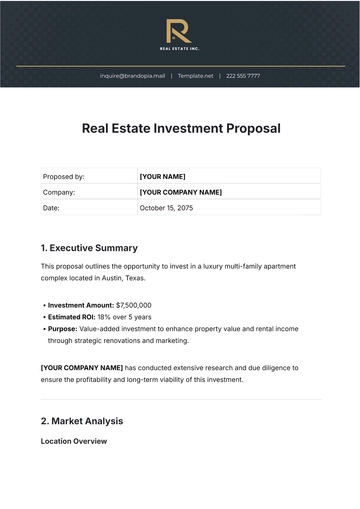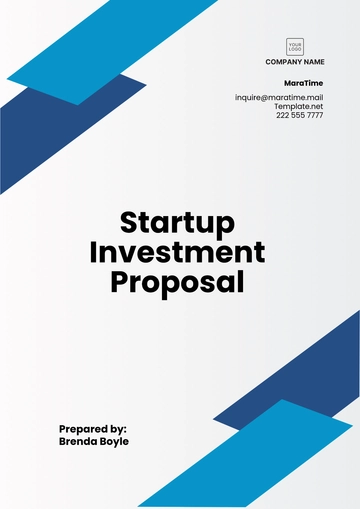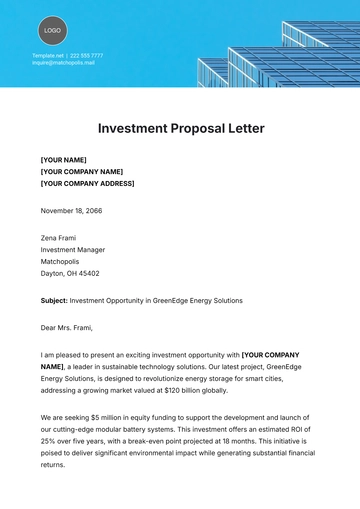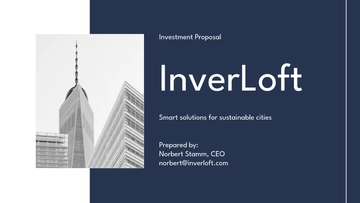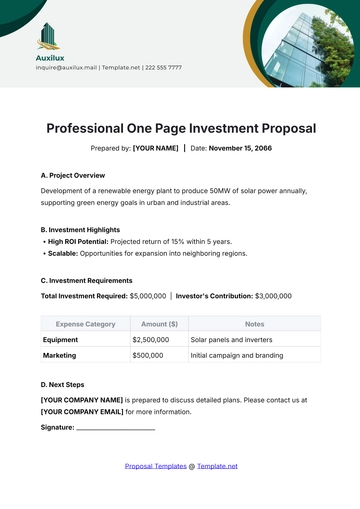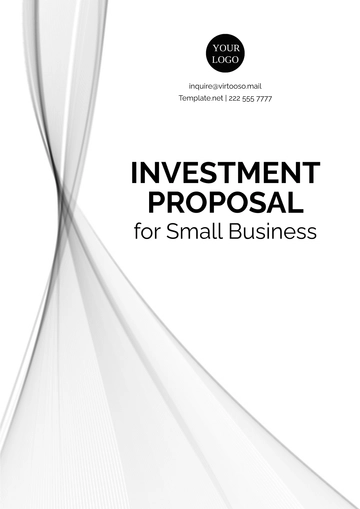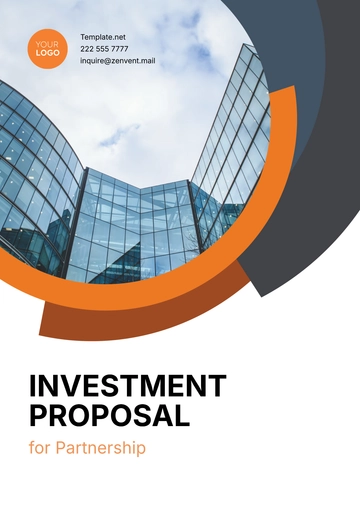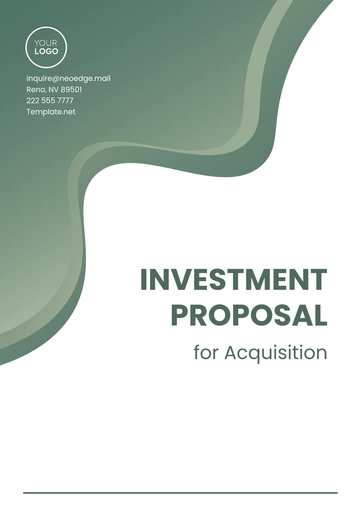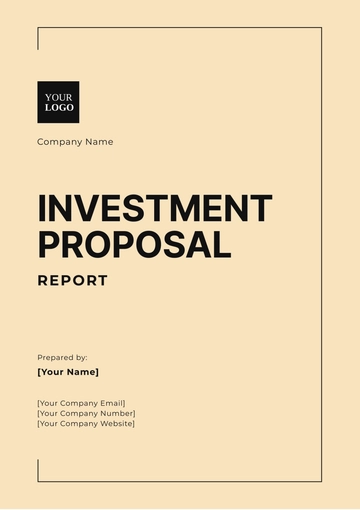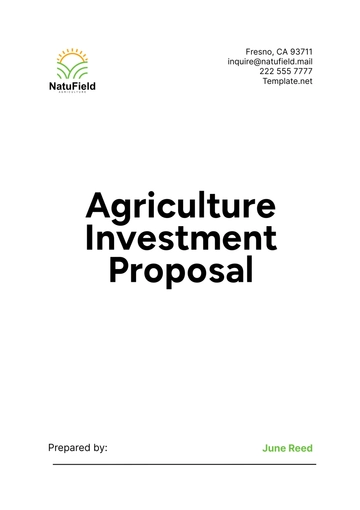Free Agriculture Investment Proposal
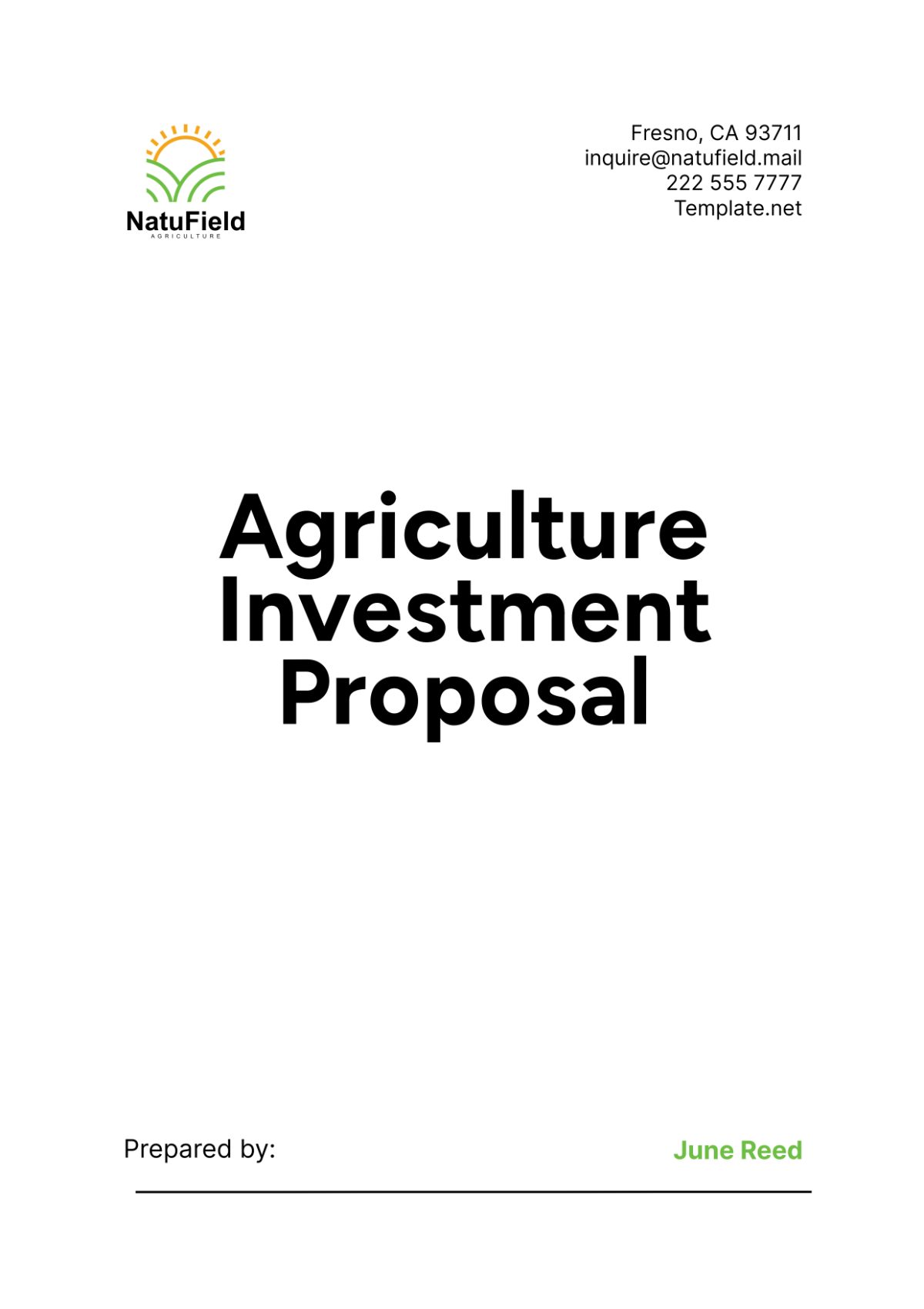
I. Executive Summary
A. Introduction
Agriculture has always been a cornerstone of economic stability and growth, playing a vital role in feeding the world's population and providing raw materials for various industries. The global demand for agricultural products is steadily increasing, driven by population growth, rising incomes, and changing dietary preferences. This growing demand presents a significant opportunity for investors to engage in a sector that promises both sustainability and profitability. [Your Company Name] seeks to capitalize on this demand by investing in modern agricultural practices that ensure high yields, sustainability, and profitability. By leveraging cutting-edge technologies and sustainable farming practices, we aim to revolutionize the agricultural sector and contribute to global food security.
B. Investment Overview
[Your Company Name] aims to invest in a state-of-the-art agricultural project that incorporates advanced technologies such as precision farming, automated irrigation systems, and high-efficiency crop management practices. This proposal outlines the investment opportunity, projected returns, and the strategic advantages of entering the agricultural sector at this time. Our investment strategy focuses on integrating innovation with sustainability to achieve maximum productivity and profitability. The project will be implemented in phases, ensuring careful planning, execution, and monitoring at every stage. This approach minimizes risks and maximizes returns, making it an attractive investment proposition for stakeholders.
C. Financial Highlights
Total Investment Required: $10 million, covering land acquisition, infrastructure development, equipment procurement, and initial operating expenses.
Projected Annual Revenue: $15 million by Year 5, driven by high-value crop production and efficient market penetration.
Net Profit Margin: 20% by Year 3, reflecting strong operational efficiency and cost management.
Return on Investment (ROI): 25% per annum, showcasing the lucrative nature of the agricultural sector when managed effectively.
Payback Period: 4 years, indicating a swift return of initial capital investment and the onset of profitability.
D. Strategic Objectives
The primary objectives of this investment are to:
Achieve high crop yields through the use of modern farming techniques that optimize resource use and increase productivity.
Ensure sustainability by adopting eco-friendly practices that minimize environmental impact and promote long-term soil health.
Maximize profitability and shareholder value by leveraging advanced technologies and efficient management practices.
Contribute to local and global food security by producing high-quality, nutritious crops that meet the demands of diverse markets.
II. Market Analysis
A. Industry Overview
The global agricultural industry is valued at approximately $3.5 trillion and is expected to grow at a compound annual growth rate (CAGR) of 4% over the next decade. This growth is fueled by several factors, including increasing population, urbanization, and changing dietary habits towards more plant-based and organic foods. The industry is also witnessing significant technological advancements that are enhancing productivity, efficiency, and sustainability. Innovations such as precision farming, automation, and biotechnology are transforming traditional farming methods, making agriculture more efficient and sustainable.
B. Target Market
Geographic Focus:
The primary focus will be on North America and Europe, where the demand for organic and sustainably grown produce is high. These regions have well-developed markets with consumers willing to pay a premium for quality and sustainability.
Secondary markets include Asia and Africa, which offer significant growth potential due to their large populations and rising income levels. These regions are rapidly urbanizing and their middle classes are expanding, leading to increased demand for diverse and high-quality agricultural products.
Demographic Focus:
Health-conscious consumers who prefer organic and sustainably grown produce. This segment is growing rapidly as more people become aware of the health benefits of organic foods.
Large retailers and wholesalers seeking reliable suppliers of high-quality agricultural products to meet the increasing demand for fresh and organic produce.
Food processing companies requiring consistent and large volumes of raw materials to produce value-added products such as organic juices, snacks, and ready-to-eat meals.
C. Competitive Analysis
The agricultural sector is highly competitive, with numerous players ranging from small family farms to large agribusinesses. However, [Your Company Name] aims to differentiate itself through:
Technological Integration: Utilizing cutting-edge technologies to enhance productivity and reduce costs. This includes precision farming tools, automated irrigation systems, and advanced crop monitoring techniques.
Sustainability Practices: Adopting eco-friendly farming practices to appeal to environmentally conscious consumers. This involves using organic fertilizers, implementing water conservation methods, and minimizing the use of synthetic chemicals.
Quality Assurance: Implementing stringent quality control measures to ensure the highest standards of produce. This includes regular testing of soil and water, monitoring crop health, and obtaining organic and other relevant certifications.
D. Market Trends
Organic Farming: Increasing consumer preference for organic products is driving the growth of organic farming. This trend is supported by growing awareness of the health and environmental benefits of organic foods.
Sustainable Agriculture: There is a growing emphasis on sustainability and environmentally friendly farming practices. Consumers and governments are increasingly demanding that food production be sustainable, leading to greater adoption of eco-friendly practices.
Technological Advancements: Innovations such as precision farming, drone technology, and artificial intelligence (AI) are revolutionizing the agricultural sector. These technologies help farmers optimize resource use, improve crop yields, and reduce environmental impact.
III. Project Plan
A. Project Description
The proposed agricultural project involves the establishment of a 1,000-acre farm in [Location], equipped with modern infrastructure and advanced farming technologies. The farm will primarily produce high-value crops such as organic vegetables, fruits, and grains. The selection of crops will be based on market demand, soil suitability, and climatic conditions. By focusing on high-demand crops, the project aims to maximize revenue and profitability while ensuring sustainable farming practices.
B. Project Timeline
Phase 1: Planning and Land Acquisition (Months 1-3)
Identify and acquire suitable farmland. This involves evaluating potential sites based on soil quality, water availability, and proximity to markets.
Conduct soil testing and environmental assessments to ensure the land is suitable for the planned crops and to identify any potential environmental risks.
Develop detailed project plans and secure necessary permits. This includes obtaining licenses for water usage, building permits for infrastructure development, and certifications for organic farming.
Phase 2: Infrastructure Development (Months 4-9)
Construct irrigation systems, greenhouses, and storage facilities. The irrigation system will be designed to optimize water usage and minimize wastage, while greenhouses will provide controlled environments for high-value crops.
Install automated farming equipment and precision farming tools. This includes GPS-guided tractors, drones for crop monitoring, and automated irrigation systems.
Set up necessary utilities and support infrastructure. This involves ensuring access to reliable electricity, water, and transportation networks.
Phase 3: Planting and Initial Cultivation (Months 10-12)
Prepare soil and plant initial crops. Soil preparation involves plowing, fertilizing, and ensuring optimal conditions for seed germination.
Implement crop management practices and monitor growth. This includes regular monitoring of soil moisture, nutrient levels, and pest control measures.
Phase 4: Full-Scale Operations (Year 2 onwards)
Expand cultivation to the entire farm. This involves scaling up operations based on initial results and market demand.
Optimize farming practices based on initial results. This includes refining irrigation schedules, adjusting fertilization rates, and implementing best practices for crop rotation.
Begin harvesting and distribution of produce. The produce will be harvested at peak ripeness to ensure the highest quality and nutritional value.
C. Financial Plan
1. Capital Requirements
Expense Category | Amount (in million $) |
|---|---|
Land Acquisition | 2.0 |
Infrastructure Development | 3.0 |
Equipment and Technology | 2.5 |
Initial Operating Expenses | 1.0 |
Contingency Fund | 1.5 |
Total Investment Required | 10.0 |
The capital requirements are meticulously calculated to cover all aspects of the project, ensuring that the farm is equipped with state-of-the-art infrastructure and technology. The contingency fund is allocated to handle any unforeseen expenses, ensuring smooth project execution.
2. Revenue Projections
Year | Revenue (in million $) | Expenses (in million $) | Net Profit (in million $) |
|---|---|---|---|
1 | 3.0 | 2.5 | 0.5 |
2 | 6.0 | 4.5 | 1.5 |
3 | 9.0 | 6.0 | 3.0 |
4 | 12.0 | 7.0 | 5.0 |
5 | 15.0 | 8.0 | 7.0 |
The revenue projections are based on conservative estimates, reflecting the anticipated market demand and productivity levels. As the farm reaches full operational capacity, revenues are expected to grow significantly, driven by high-value crop production and efficient market penetration.
D. Risk Analysis
Market Risks: Fluctuations in market prices for agricultural products can impact revenue. To mitigate this risk, [Your Company Name] will engage in market research and establish long-term contracts with buyers to ensure stable prices and demand.
Operational Risks: Potential challenges in managing large-scale farm operations and maintaining high productivity. To address this, the project will employ experienced farm managers and agronomists, and implement advanced farm management systems.
Environmental Risks: Adverse weather conditions and climate change can affect crop yields. The project will incorporate climate-resilient farming practices and invest in crop insurance to mitigate the impact of environmental risks.
Financial Risks: Potential cost overruns and delays in project implementation. To mitigate this, a contingency fund is included in the budget, and strict financial controls and monitoring mechanisms will be implemented.
IV. Implementation Strategy
A. Technology Integration
Precision Farming: Use of GPS and GIS technologies to monitor and manage crops with high precision. This includes soil mapping, variable rate technology for fertilization, and precision irrigation systems to optimize water usage.
Automation: Implementing automated systems for planting, irrigation, and harvesting to increase efficiency and reduce labor costs. This includes automated tractors, irrigation systems, and harvesting machines.
Data Analytics: Utilizing data analytics to monitor crop health, predict yields, and optimize resource use. This involves collecting data from various sensors and using AI algorithms to analyze the data and provide actionable insights.
B. Sustainable Practices
Organic Farming: Adopting organic farming methods to produce high-quality, chemical-free crops. This includes using organic fertilizers, natural pest control methods, and crop rotation practices to maintain soil health.
Water Conservation: Implementing efficient irrigation systems and water management practices to minimize water usage. This includes drip irrigation systems, rainwater harvesting, and soil moisture sensors to optimize water usage.
Renewable Energy: Utilizing renewable energy sources such as solar and wind power to reduce the farm's carbon footprint. This involves installing solar panels and wind turbines to generate clean energy for farm operations.
C. Workforce Development
Training Programs: Providing training and development programs for farm workers to enhance their skills and knowledge. This includes training on modern farming techniques, safety protocols, and equipment operation.
Community Engagement: Engaging with local communities to create job opportunities and promote sustainable farming practices. This involves partnering with local organizations and conducting outreach programs to educate the community on the benefits of sustainable agriculture.
Health and Safety: Implementing strict health and safety protocols to ensure the well-being of farm workers. This includes providing personal protective equipment, conducting regular safety training, and ensuring compliance with health and safety regulations.
V. Financial Projections
A. Profit and Loss Statement
Year | Revenue (in million $) | Cost of Goods Sold (in million $) | Gross Profit (in million $) | Operating Expenses (in million $) | Net Profit (in million $) |
|---|---|---|---|---|---|
1 | 3.0 | 1.5 | 1.5 | 1.0 | 0.5 |
2 | 6.0 | 3.0 | 3.0 | 1.5 | 1.5 |
3 | 9.0 | 4.0 | 5.0 | 2.0 | 3.0 |
4 | 12.0 | 5.0 | 7.0 | 2.0 | 5.0 |
5 | 15.0 | 6.0 | 9.0 | 2.0 | 7.0 |
The profit and loss statement reflects the financial performance of the project over a five-year period. The figures indicate a steady increase in revenue and profitability, driven by efficient operations and market demand.
B. Cash Flow Statement
Year | Cash Inflows (in million $) | Cash Outflows (in million $) | Net Cash Flow (in million $) |
|---|---|---|---|
1 | 3.0 | 2.5 | 0.5 |
2 | 6.0 | 4.5 | 1.5 |
3 | 9.0 | 6.0 | 3.0 |
4 | 12.0 | 7.0 | 5.0 |
5 | 15.0 | 8.0 | 7.0 |
The cash flow statement highlights the movement of cash in and out of the project. Positive net cash flow from Year 1 onwards indicates the project's ability to generate sufficient cash to cover operating expenses and investments.
C. Balance Sheet
Assets (in million $) | Year 1 | Year 2 | Year 3 | Year 4 | Year 5 |
|---|---|---|---|---|---|
Current Assets | 2.0 | 4.0 | 6.0 | 8.0 | 10.0 |
Fixed Assets | 8.0 | 8.0 | 8.0 | 8.0 | 8.0 |
Total Assets | 10.0 | 12.0 | 14.0 | 16.0 | 18.0 |
Liabilities and Equity (in million $) | Year 1 | Year 2 | Year 3 | Year 4 | Year 5 |
Current Liabilities | 1.0 | 1.5 | 2.0 | 2.5 | 3.0 |
Long-term Liabilities | 4.0 | 4.0 | 4.0 | 4.0 | 4.0 |
Equity | 5.0 | 6.5 | 8.0 | 9.5 | 11.0 |
Total Liabilities and Equity | 10.0 | 12.0 | 14.0 | 16.0 | 18.0 |
The balance sheet provides a snapshot of the project's financial position at the end of each year. It shows the growth in assets and equity, indicating the increasing value of the investment over time.
VI. Strategic Partnerships
A. Supplier Partnerships
Seed Suppliers: Partnering with leading seed suppliers to ensure access to high-quality seeds that are resistant to pests and diseases. This includes collaborating with companies that provide genetically modified seeds for better yields.
Equipment Manufacturers: Establishing relationships with manufacturers of farming equipment to procure advanced machinery at competitive prices. This includes securing maintenance and support services to ensure the longevity and efficiency of the equipment.
Fertilizer and Pesticide Suppliers: Partnering with suppliers of organic fertilizers and eco-friendly pesticides to maintain soil health and ensure sustainable farming practices. This includes sourcing products that comply with organic farming standards.
B. Distribution Partnerships
Retail Chains: Forming partnerships with major retail chains to distribute produce directly to consumers. This involves securing contracts with supermarkets, grocery stores, and specialty food retailers to ensure a steady market for the produce.
Wholesale Distributors: Collaborating with wholesale distributors to reach a broader market and increase sales volumes. This includes working with distributors who specialize in organic and high-quality produce.
Food Processing Companies: Partnering with food processing companies to supply raw materials for the production of value-added products. This includes providing consistent and large volumes of high-quality produce to manufacturers of organic juices, snacks, and ready-to-eat meals.
C. Research and Development Partnerships
Agricultural Research Institutions: Collaborating with research institutions to stay abreast of the latest advancements in agricultural science and technology. This includes participating in research projects and adopting new practices and technologies.
Technology Providers: Partnering with technology providers to integrate advanced solutions such as AI, IoT, and blockchain into farming operations. This involves working with companies that develop precision farming tools, data analytics platforms, and supply chain management systems.
Universities and Colleges: Engaging with academic institutions to foster innovation and provide training opportunities for students. This includes establishing internships, sponsoring research projects, and offering scholarships to students pursuing degrees in agriculture.
VII. Conclusion
A. Summary
The proposed agricultural investment by [Your Company Name] presents a lucrative opportunity to capitalize on the growing demand for high-quality, sustainably grown produce. By leveraging advanced farming technologies and adopting eco-friendly practices, [Your Company Name] aims to achieve high yields, profitability, and long-term sustainability. The project is designed to integrate modern technology with traditional farming methods to create a productive and sustainable agricultural operation. The strategic objectives, market analysis, and financial projections outlined in this proposal demonstrate the viability and potential profitability of the investment.
B. Call to Action
We invite potential investors to join us in this exciting venture and contribute to the future of sustainable agriculture. Together, we can create a profitable business while making a positive impact on the environment and society. Investing in this project not only promises attractive financial returns but also aligns with the global movement towards sustainability and environmental stewardship. By supporting this initiative, investors can be part of a forward-thinking enterprise that addresses the challenges of food security and sustainable farming.
C. Contact Information
For further information or to discuss this proposal in detail, please contact:
[Your Name]
[Your Company Name]
[Your Company Email]
[Your Company Address]
[Your Company Number]
- 100% Customizable, free editor
- Access 1 Million+ Templates, photo’s & graphics
- Download or share as a template
- Click and replace photos, graphics, text, backgrounds
- Resize, crop, AI write & more
- Access advanced editor
Attract investors with the Agriculture Investment Proposal Template on Template.net. It's customizable and editable, designed for funding pitches. Utilize our Ai Editor Tool to outline project details and benefits, securing financial support for agricultural growth and innovation.
You may also like
- Business Proposal
- Research Proposal
- Proposal Request
- Project Proposal
- Grant Proposal
- Photography Proposal
- Job Proposal
- Budget Proposal
- Marketing Proposal
- Branding Proposal
- Advertising Proposal
- Sales Proposal
- Startup Proposal
- Event Proposal
- Creative Proposal
- Restaurant Proposal
- Blank Proposal
- One Page Proposal
- Proposal Report
- IT Proposal
- Non Profit Proposal
- Training Proposal
- Construction Proposal
- School Proposal
- Cleaning Proposal
- Contract Proposal
- HR Proposal
- Travel Agency Proposal
- Small Business Proposal
- Investment Proposal
- Bid Proposal
- Retail Business Proposal
- Sponsorship Proposal
- Academic Proposal
- Partnership Proposal
- Work Proposal
- Agency Proposal
- University Proposal
- Accounting Proposal
- Real Estate Proposal
- Hotel Proposal
- Product Proposal
- Advertising Agency Proposal
- Development Proposal
- Loan Proposal
- Website Proposal
- Nursing Home Proposal
- Financial Proposal
- Salon Proposal
- Freelancer Proposal
- Funding Proposal
- Work from Home Proposal
- Company Proposal
- Consulting Proposal
- Educational Proposal
- Construction Bid Proposal
- Interior Design Proposal
- New Product Proposal
- Sports Proposal
- Corporate Proposal
- Food Proposal
- Property Proposal
- Maintenance Proposal
- Purchase Proposal
- Rental Proposal
- Recruitment Proposal
- Social Media Proposal
- Travel Proposal
- Trip Proposal
- Software Proposal
- Conference Proposal
- Graphic Design Proposal
- Law Firm Proposal
- Medical Proposal
- Music Proposal
- Pricing Proposal
- SEO Proposal
- Strategy Proposal
- Technical Proposal
- Coaching Proposal
- Ecommerce Proposal
- Fundraising Proposal
- Landscaping Proposal
- Charity Proposal
- Contractor Proposal
- Exhibition Proposal
- Art Proposal
- Mobile Proposal
- Equipment Proposal
- Student Proposal
- Engineering Proposal
- Business Proposal



